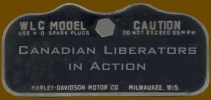

Classic WLCs in Wartime Photos
|
|
'42WLC Model' An unidentified Canadian Serviceman poses on a 42WLC in front of the Army Barracks. The
photo gives a clear view of the high mounted headlight and marker light of
the early 42WLC. A number '13' has been painted on the front fender tip. No other markings are visible in the photo. |
|
'Check Point' |
|
Corporal
Power of the Canadian Provost Corps checks the driver of a Ford sedan
for his license and other paperwork. The bike is perfect example of the
42WLC Model with high headlight and auxiliary tool box on the front
fender. The tandem seat has been taken off. White painted fenders and
bumpers and Black-Out shrouds on the headlights and fender light suggest this photo was
taken somewhere in England. |
|
'Dispatch-Rider' Private
J.W. King (left) accepts a pigeon message from corporal J Honley of the
Royal Canadian Corps of Signals somewhere in England. The image offers a clear view on the 42WLC Model with Auxiliary Tool Box on the front fender. Although the tandem seat has been taken off, the passenger foot peg and bracket are still attached to the rear forks. The Auxiliary Stop Light Switch is visible on the frame just above the rear end of the tool box. The marking on the oil tank is a white and light blue square indicating a Corps of Signals unit; the number '9' remains a mystery. The vehicle number has rubbed off from the oil tank. |
|
|
|
'Checking the map...' Dispatch-Riders Doug Reid and Norman Given of the 9th Infantry Brigade checking the route of a convoy taking part in a training exercise in England on May 17 1944. Another
interesting view of the 42WLC as used in England; and again the
tandem seat is removed. The round oil filter is barely visible in the
photo towards the back of the rear cylinder head. The air cleaner bracket
can be seen bolted to the upper battery box and rear fender bolts. Note the Vehicle Registration Number CC-1040822 on the gas (petrol) tank. Both
riders are equipped with US Made M1938 Resistal Goggles, the pair worn by
Reid have the Canadian 'Broad Arrow' acceptance stamp just visible above
the left eye piece. |
|
'On the Way
to Brussels' |
|
Cromwell
tanks of the British Guards Armoured Division drive thru Halle on their
way to Brussels on September 4th, 1944. They are cheered on by the
crowds, but a number of them seem to have a special interest in the
motorcycle of which the windshield is visible in the photo's lower
right. Unmistakingly it's a WLC, although it's not clear whether or not
the Guards were issued these bikes..... A mystery.... |
|
'Canadian Liberator' |
|
On September 12th, the 12th Manitoba
Dragoons of Canada liberated the Belgian Town of Brugge. |
|
'Royal Air Force
WLCs' |
|
Above are two images of 43WLC bikes in use by the British. The Royal Air Force
used a considerable number of Harleys. It is still not clear if these were
supplied from Canadian stocks or if they were delivered by the US under the 'Lend-Lease
Act'. Although the foot clutch and
hand-gearshift made them unpopular with the British riders who were unfamiliar
with that; the ride comfort soon made up for this. Both pictures show Dispatch
Riders of the 83rd Group, 2nd Tactical Air Force (RAF). The markings show the
RAF Serial Number (RAF157684 on the right picture) on the front fender with the
unit marking underneath. The meaning of the letter 'M' has not been determined.
Maybe it stands for 'Medium'? These bikes would have been delivered in factory
US Olive Drab and would not have been repainted until after the war. Oddly the
front Black-Out light seems absent on both bikes...... |
|
|
|
This 43WLC
was photographed in front of the railway station of Middelburg, SouthWest
Holland between the 7th and 10th November 1944. The motorcycle as well as the
Humber Light Reconnaissance Cars in the background belong to the Royal Air
Force' 2777th Field Squadron, 84th Group, RAF Regiment which was on Walcheren to
find a suitable place to install the RAF experimental radar 'NELLY". |
|
'Riding Out' This
Canadian Officer(?) takes a 'Export' 43WLC out for a ride. |
|
|
'Dutch Spring' |
|
Two Canadians
ride their 43WLC near Nijmegen, Holland in the spring of 1945. |
|
|
'Pick your WLC...!...' At an Ex-Canadian Army Depot in Holland shortly after WW2, Dutch civilians are going thru a dump filled with WLC motorcycles. A
couple of British made bikes are visible, but most seem to be either 42WLC
or 43WLC Models. This might explain why so many ex-military Harleys ended up in Holland after 1945. |
|
|
'Belgians Can Do Too!...' Herman Wirix poses on a Royal Air Force marked WLC in Germany. The bike may have come from the British, or it may directly have been supplied by the US under 'Lend-Lease' Wirix served as a
member of the Belgian Auxiliary Air Police Service (BAAPS) with the RAF. The
bike is a 43WLC Model set up in 'Export' version. A Black Out Shroud has
been added to the Headlight. It is equipped with a windshield with
leatherette apron. The extra stand mounted to the front axle is just
visible. The bike is marked to the RAF Police attached to Tactical Air Force (Police?) Headquarters (TAF PHQ). Note the RAF Registration Number RAF 157554 painted on the oil tank. Crashbars have been painted white... This picture was probably taken in or around Bad-Meinberg on March 16th, 1946... |
|
|
'Belgians & Canadians' After WW2, Germany was divided in different Occupation Zones and the area stretching from the Belgian border to the East was occupied by the 1st Belgian Corps. There were Belgians in Soest (Nordrhein-Westfalen) until 1994, when the 4th Belgian Brigade was disbanded. Shown
left are two riders, one from an unknown Belgian unit and another of the
Canadian Army. The uniforms, Sten Gun and insignia
all date this picture to the early 1950's. The WLC
on the right is
a standard 43WLC 'Export' version with the rear
luggage carrier removed. Note the GMC Truck in the background. The Belgians would use these trucks well into the 1970's..... (Thanks to M Bogaert for identifying this road in Soest) |
'The Big and
Small of It'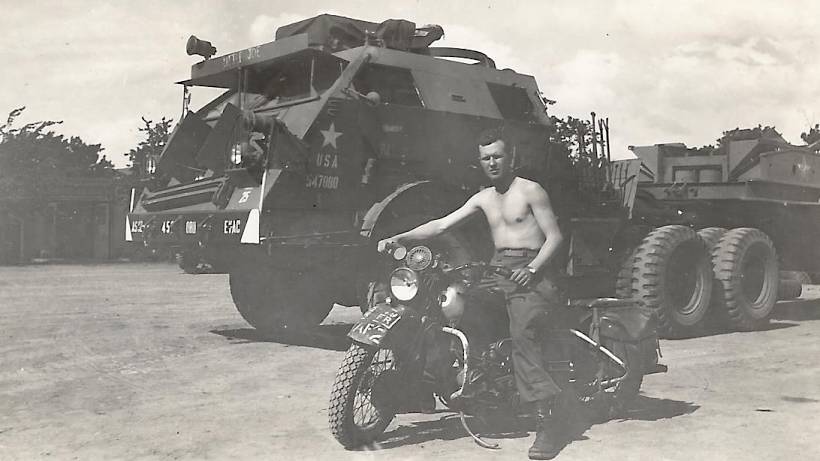 Photo from the Webmaster's Collection |
|
This picture taken at Hofgeismar, Germany, in July 1945 shows both the biggest and smallest of vehicles produced in the US during WW2. A soldier clearly identified by the trousers and 'Double Buckle' Combat Boots as an American GI, sits on a 43WLC with British Royal Air Force markings in front of an M26 Pacific Tank Transporter. The
markings on the M26 are ASCZ 45? ORD EVAC, which means the vehicle
belonged to an Ordnance Evacuation Company attached to the Advance
Section of the Communication Zone... The company number is most likely
the 456th, but could be the 455th or 458th... The vehicle carries the
nickname LITTLE JOE above the windscreen... This picture came from the effects of a soldier of the 307th Field Artillery Battalion of the 78th Division... |
'Yes, the US Army used the WLC during WW2!....'
The pictures
below prove the WLC Model was used by the US Army during WW2.
There are
a few other pictures showing WLCs in use by a US Army MP Unit in the
Continental USA, but their use remains highly exceptional.
There's has been no documentation available to establish why and how
many WLCs were delivered to the US Army.
'9th
Air Force Signal Corps Messenger'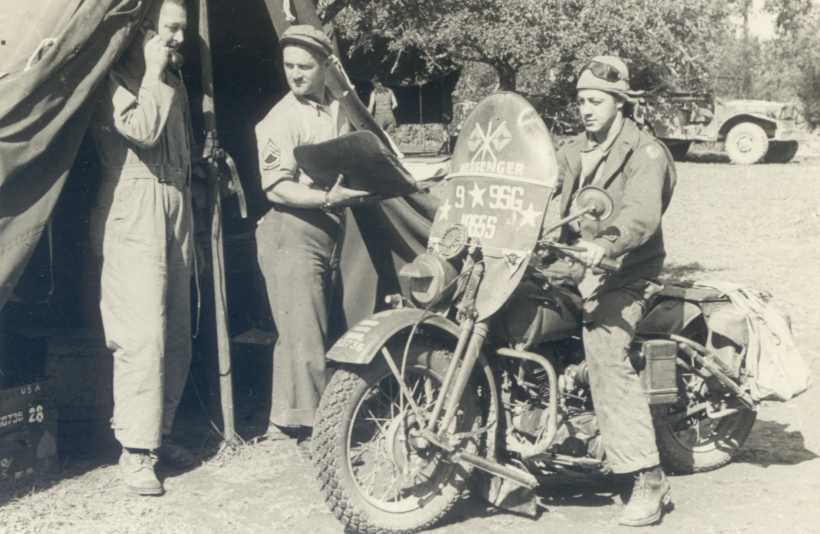 Photo from the Webmaster's Collection |
These pictures show a WLC in use by a Signal Corps unit of the US 9th Army Air Force in Europe during WW2. The above
picture shows the bike just prior to, or just after the Normandy landings,
either in Britain or France. Below are two
more pictures of the same bike with the same GI's, posing with a local girl and
her father. Note the wear of both patterns British Made ETO jackets and the USAAF Shearling Flying Trousers worn by the rider below right. |
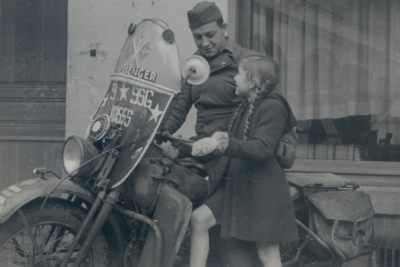
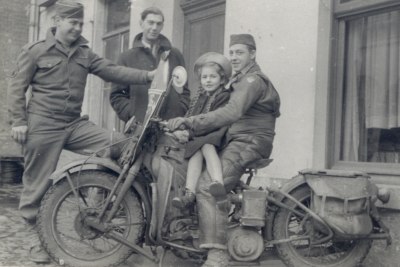 Photos from the Webmaster's Collection |
|
|
'Another US Army WLC!!...' Three GIs fool around on a motorcycle somewhere in the ETO in 1944/45. Although the soldiers
are clearly American, the bike is definitely a WLC evidenced by the small
CMP Rear Lights and the Rear Stand equipped with Sand Pads. A small plate bearing
the number X-62070 has been attached underneath the rear lights. Two GIs are wearing British Made ETO Field Jackets which confirms these men belonged to an Army Air Force unit which were issued these garments in large quantities. |
|
|
'2 GI's on WLC?!?' Two GI's pose on a Liberator, near the end of WW2 in Europe. Although
the bike looks like a WLA at first glance, some details indicate that it's
most probably a WLC. The windshield apron marking tells us the bike belongs to a 3rd Army unit. |
'Military
Police Line-Up' Photo from the Webmaster's Collection |
|
The
Jeeps and Motorcycles above are marked to a US Army Military Police
unit. While
the bike in the foreground is clearly a WLA, the other three motorcycles
are WLC Models. |
|
|
My sincere thanks to Prem Zizka and Frank Berg, as these WLC-pages would not have been made without their support and encouragement, to James Thompson for sending me several photos and to Clive Law who has been a great help in gathering information!